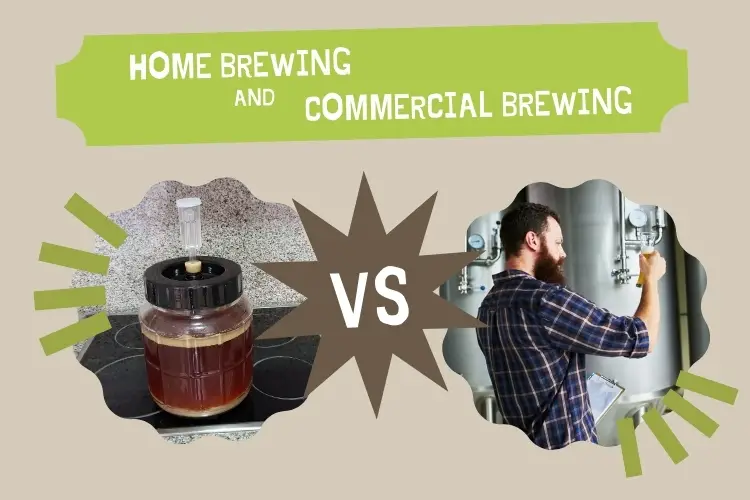As evidenced by the 7,000 + extant breweries in the US right now, many homebrewers and enthusiasts have gone strictly commercial.
Here are 6 things differences between home brewing and commercial brewing to consider. Sharing beer with others and making a good living is a noble goal.
Homebrewing and Commercial brewing hold many similarities and differences. Here are 6 differences to inform the passionate brewer and better prepare the future entrepreneur. Some are driven to be pro brewers and will not stop until they helm a commercial brewhouse.
Read this for enjoyment, data research, or part of the process of manifesting the commercial dream.
As one dreams of professional brewing glory, allow this to be part of the puzzle which impels a bold move forward or taking a step back.
1) All-grain mastery and recipe formulation
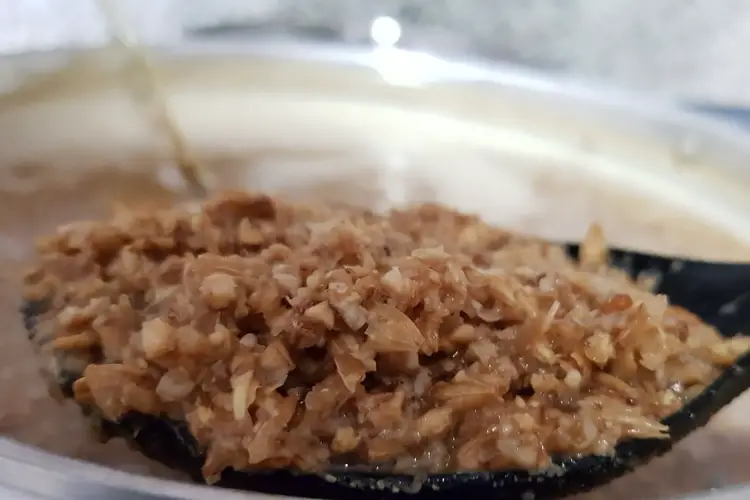
There are extract breweries out there.
Yet, extract is expensive and raw barley malt is not.
To build a thriving microbrewery, it must be an All-Grain system.
At a commercial level, extract costs roughly $2.50 a pound and Barley malt about $0.50.
Master the art of mashing and producing all grain beer.
It is a bit trickier than extract brewing yet quite rewarding and a sublime way to spend cool spring and fall Saturday mornings.
For understanding recipe formulation in great detail, please refer to our article How to Make Your Own Beer Recipe – 4 Tips.
If you wish to be the brewmaster at your pub or micro plant, you really must master the craft.
This will take a minimum of 40 – 75 batches the last 35 being All- Grain, to reach even a cursory understanding of the complete process.
2) Utilizing IBUs and Hop Isomerization
For commercial brewing you will brew anywhere for example, 3.5 – 20 barrels of beer (1 US bbl. = 31 gal.).
Formulating for homebrewing is simple by comparison.
The hop oils are in the can, you follow the directions of your homebrew shop owner, or you use the HBU method, made popular by Charlie Papazian in by my estimate, the homebrewers bible, The Complete Joy of Homebrewing; now in its 4th edition.
In HBU formulation just simply add the alpha units of each ounce of hops, and you get your general bitterness level and hop effect, of the beer.
Example:
- 2 ounces of Perle, 7.2% alpha – to bitter
- 1 ounce of Hersbrucker, 3.2 % – to flavor
- 2 ounces of Hersbrucker – aroma
Perle, 14.4 + Hers., 9.6 = 24 HBUs
We know that the bitterness from the Perle and the flavoring attributes of Hersbrucker will add different qualities to the beer, not all bitter.
Either way, in the words of one of the greats, Papazian himself, Relax, have a homebrew.
He certainly was instrumental in my earliest brewing days.
Exploring and using IBUs is not too difficult but takes practice.
The formula is as follows:

*It is worth noting, the utilization changes depending on time of boil. Also, the volume of wort diminishes as boil proceeds, so three separate formulations for 3 stages of hops.
The following is one example, for sample purposes only:
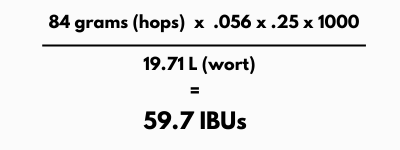
In brief, convert hops to grams for ease. Convert your gallons to liters, in this case 5.2 gallons. Multiply by 5.6% (Kent Goldings) – multiply again by .25, the percentage of utilization of first hopping – multiply again by 1000 to reconvert to milligrams.
You have formulated bitter hopping for an American Pale Ale or English ESB.
You could also easily use an IBU calculator.
3) Temperature control
Homebrewing for most of us is a Spring and Fall venture, with occasional winter and summer brews in stable temperature environments.
Our ambient temperature needs to be from 50 – 65˚F (10 – 18° C) to successfully ferment within safety parameters.
In a brewery, the tanks are double-walled, insulated, glycol jacketed stainless steel.
You cool the beer at will.
The glycol jackets are portions on the inner wall wherein propylene glycol continually circulates; a liquid coolant with a very low freezing point.
If the beer creeps up over 69˚ F (20.5° C), the glycol kicks on and turns off when the beer cools down to 67˚ F (19.5° C).
It is a strictly temperature-controlled environment.
In the summer, the glycol compressors work harder, and in winter, the insulated tank is unaffected by the cold.
My ambient temperature in winter was only about 55˚ F (12° C) at best as I had an old drafty converted lumber warehouse.
The heat was off at night, and the beer never dipped too low.
At home, short of having a garage fridge or a fermentation cabinet, we are subject to the elements, too hot or too cold.
It is reasonable enough to work within these parameters and there are techniques and simple hacks to get around it.
These are documented at length, How Do You Brew Beer in Hot Weather? and How Do You Brew Beer in Cold Weather?
4) Creating and maintaining a sanitary environment
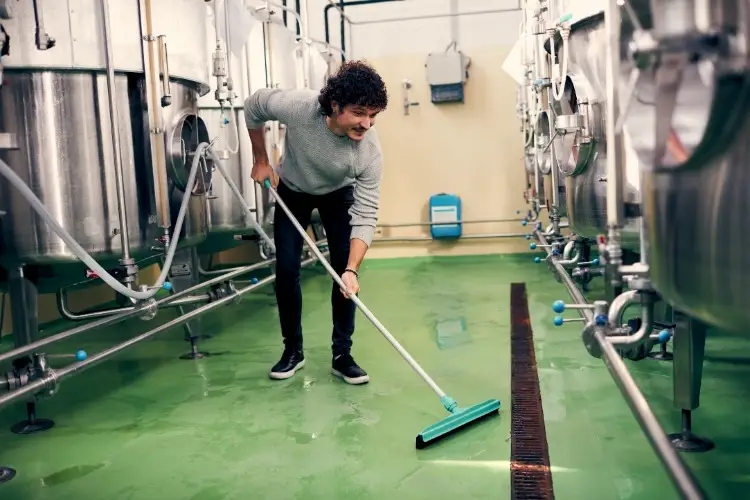
In brewing, there is no such thing as too clean.
By clean, this is not only free of dirt but sanitary – bacteria free.
Something that is visibly clean will have surface microflora contaminates.
At home use bleach, B-Brite or Star San cleaner for bacterial control.
Sanitizers cannot clean dirt.
If you have discolored abraded, or scratched post-boil brewing equipment at home, THROW IT AWAY, and get new ones.
One exception is if you use an iodine solution to sanitize. It will discolor plastic. This is OK, but as the discoloration could mask dirt, dried beer residue, gunk, perhaps it is not the best choice for home brewing sanitation.
Breweries have to sell their beer. While this vital tidbit is hidden away in the sanitation section, it is nonetheless fitting.
To survive, you must sell and thrive.
If you are not fastidiously clean, you will fail.
Commercial brewers also use many harsh, corrosive chemicals to scrub and sanitize.
We wear heavy gloves and ventilators to handle them.
It’s not a big deal, just very different form than relaxing Saturday morning brew session at home.
5) High-Overhead: the business end
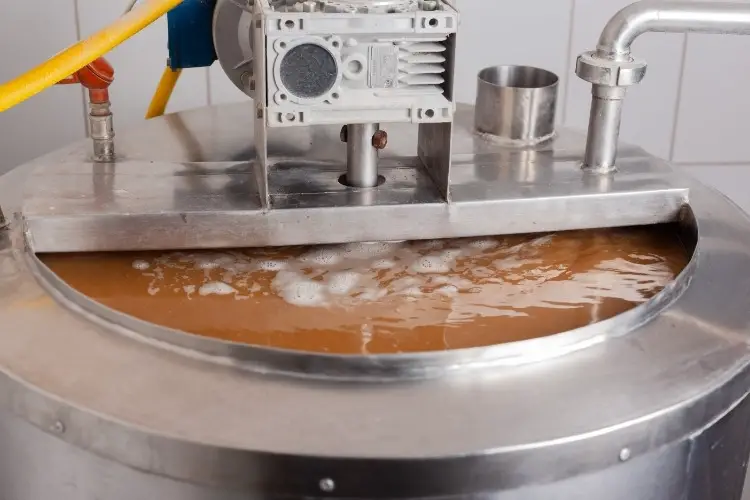
Building a nice All-Grain set-up is manageable and may be done in stages.
As the process and skills advance from Beginner> Intermediate > Journeyman > Advanced brewer, equipment is acquired along the way.
Using coolers, old plastic fermenters, pickle buckets, and a host of kitchen utensils, combined with a few specialties like a grain mill, sparger, copper coil wort chiller, the cash outlay for brewing is only about $300 – 500 tops, spread out over 2 – 3 years.
Depending on the time and dedication, it could easily take this much time to reach the 25 – 50 batch benchmarks to need all of this stuff.
Commercial brewing on the other hand is capital intensive.
Even if you beg, borrow and steal (expression only!), salvaging equipment from old dairies, buying used and doing the lion’s share of work (installation and build out) yourself, you are looking at 75 – 100K.
This could build a 7-barrel brewery with a small taproom, if one garners and utilizes every bit of social and family capital at their disposal.
Otherwise, the low-end for investment would be 150 – 250K.
Not a lot for some, yet a real stretch for most.
Here are some articles which discuss commercial brewing ventures at length: Microbrewery Equipment List: All You Need to Get Started and How Much Does It Cost to Start a Microbrewery?
6) Artisan Qualities and Inner Drive
In my view, brewing takes more than science, the ability to read a recipe, and follow rules.
It takes an innate connection to the heart of the process.
Understand everything about it, chemically, environmentally, and culturally.
There is a reason the most unique, complex beers come from Belgium, the finest lagers from Germany (and the Czech Republic) and the finest ales from England.
It is their culture, their life blood, their raison d’être.
Yes, business acumen, science, market awareness, are all essential in commercial ventures.
However, if one hasn’t the drive to find the answers of Life, the Universe and Everything with beer as the vehicle for this journey, then perhaps commercial brewing is not the ideal journey for you.
No worries, brew beer and have fun!
Breaking Ground – A New Brewery?
If brewing transcends a hobby, a fun-time, and brings passion to life, commercial brewing could be a consideration.
Tread carefully, have a rock-solid, vetted business plan, and don’t look back.
